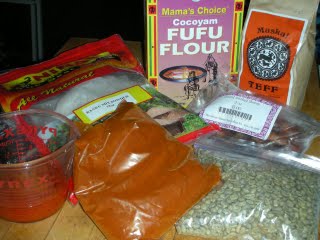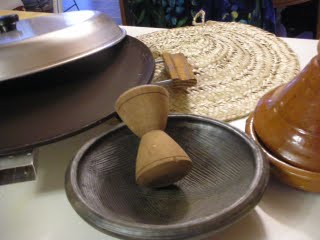Question #9: Doesn't African cooking require specialized ingredients and equipment?
 Preface to this blog posting: I saw the movie "Julie and Julia" last week, and it encouraged me to continue posting the recipes for the Ghanaian cookbook Barbara Baeta and I have worked on the past few years with basically no encouragement from publishers. Wouldn't it be wonderful to do for West African food what she did for French food? Of course, everyone already knew that French food was amazing, but for many people West African food has negative stereotypes and/or just seems inaccessible. Do try cooking some of the recipes I'll be posting, and see if you don't also fall in love with the dishes of Ghana.
Preface to this blog posting: I saw the movie "Julie and Julia" last week, and it encouraged me to continue posting the recipes for the Ghanaian cookbook Barbara Baeta and I have worked on the past few years with basically no encouragement from publishers. Wouldn't it be wonderful to do for West African food what she did for French food? Of course, everyone already knew that French food was amazing, but for many people West African food has negative stereotypes and/or just seems inaccessible. Do try cooking some of the recipes I'll be posting, and see if you don't also fall in love with the dishes of Ghana.Now to tackle question #9 about the necessity of having specialized equipment and ingredients to master African cooking.
I've lived in England, Japan, and Brazil and had cooking lessons in each place. I've also learned Indian cooking from colleagues from India, Italian cooking from Italian colleagues, Chinese cooking from Chinese colleagues. It's usually possible to re-create dishes from other cultures even without all the specialized equipment and ingredients that are native to those places.
The same is true of African cooking, whether I've been taking lessons on Moroccan cooking in Morocco, Ghanaian cooking in Ghana, or South African cooking in Cape Town . . . Of course, one cannot always get the exact ingredients and cooking equipment one might like outside of those countries, but one can generally substitute and adapt.
Plus, when things like sushi or kimchi or pad Thai make their way into our lives, we discover seaweed or bamboo mats or pickled ginger or special spices or lemongrass are actually not all that hard to locate in our cities. With the rising popularity of Latin foods and cooking in North America, along with Asian cuisines, fruits and vegetables and starches that were once unfamiliar are making their way into mainstream grocery stores: all kinds of chili peppers, ginger, tamarind, fresh and dried coconuts, mangos, papayas, yucca (cassava), cocoyams (taro), African yams, plantains--the list is practically endless. Many of these ingredients are integral to the cuisines of tropical and sub-tropical countries of Africa. Their increasing availability provides opportunities to explore a whole new world of flavors and textures. It's a very exciting development to me after many years where such foods were inaccessible or prohibitively expensive.
I further rejoice to watch Americans discover and embrace specifically African ingredients like South African rooibos (redbush) or honeybush teas.
As more African immigrants/students/professionals abroad demand the ingredients from their homelands, the market provides those things, from fresh vegetables and root crops to moinmoin powder, teff, fufu flour, smoked shrimp, dende (red palm) oil, fermented corn and cassava doughs, etc. "Ethiopian" teff is now grown in the U.S. (BTW, I'm trying to find a way to import some wonderful kpakpo shito peppers from Ghana, and have 3 organic farmers ready to grow them here! If anyone knows of any sources, please contact me at fran@betumi.com)
Having said that, there are also many dishes that can be made using familiar North American ingredients, like stews using beef, onions, tomatoes, and oil, but combined with spices and eggplant or spinach or okra or mushrooms. There are curry and rice dishes, corn dishes, and bean stews, but with interesting twists like using canned sardines or corned beef or smoked fish or pureed nuts and seeds. Of course there are numerous chicken and fish dishes, too.
So, the short answer to Question #9 above is: No, African cooking does not require excessive use of unavailable ingredients and cooking utensils!
On the other hand, for purists, rest assured that if you wish to become a master chef of any African cuisine, you can move beyond the simple to the more complex--just like any of us can make tacos or fajitas or enchiladas or burritos, but someone like Rick Bayless takes Mexican food to a whole new level. For example, last week my electric mitad arrived from Bethany Housewares. A mitad is a round griddle and lid that can be used to make injera, even though it was originally designed as a lefse maker for that Scandinavian flatbread. Incidentally, it can also be special ordered, without the lid, from Target. The previous week I was in Portland Oregon visiting family and stopped by some Ethiopian stores to buy some specialized ingredients: Ethiopian cardamon, green coffee beans, shiro powder, berbere, niter kibbeh (clarified, spiced butter), tea, alecha seasoning, and a woven mat that is used to remove the injera from the mitad. In other posts I've already praised my asanka (ridged grinding bowl from Ghana), and, yes, I have a tagine from Morocco. . . Do I absolutely need the special grill and spices to make my Ethiopian injera and stews? No. Certainly not. I made some fine flatbreads on a nonstick skillet on my stove, and I made a "make-do" version of the clarified butter myself, and even a "fake" berbere. I can also get many of the ingredients I need, from teff to millet flour to garbanzo beans and Ethiopian coffee, locally here in central Pennsylvania. And blenders and food processors do much of the work of African mortars and pestles.
However, I'm a perfectionist (I also have specialized ingredients and equipment for make other things like Japanese or Chinese foods). Since I do cooking classes, I can convince myself to spend a little extra money to purchase the spices and cooking equipment. It's also always fun to serve meals with "authentic" serving dishes/mats/tablecloths, etc.
 In summary, African cooking is quite forgiving and adaptable for novices, but there are also many layers one can explore to master more complex flavors. In other words, there's something for everyone.
In summary, African cooking is quite forgiving and adaptable for novices, but there are also many layers one can explore to master more complex flavors. In other words, there's something for everyone.As an example, today I've mixed up some corn flour/meal to ferment so that I can post the recipes for banku and Ga kenkey, two Ghanaian favorites. I have 4 options to choose from, using both local white Indian Head cornmeal and imported flours and doughs from Ghana. Check back tomorrow to learn more.
Labels: African cooking, african ingredients, asanka, bethany housewares, fufu, mitad, teff


